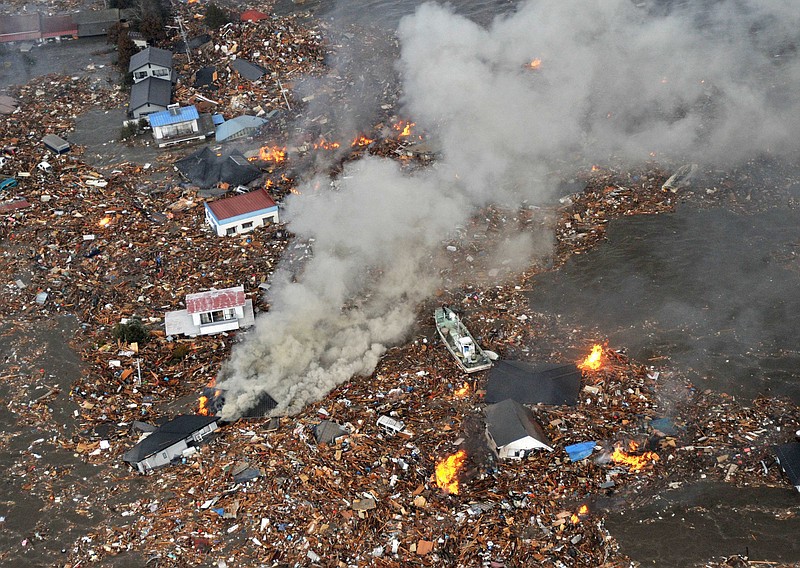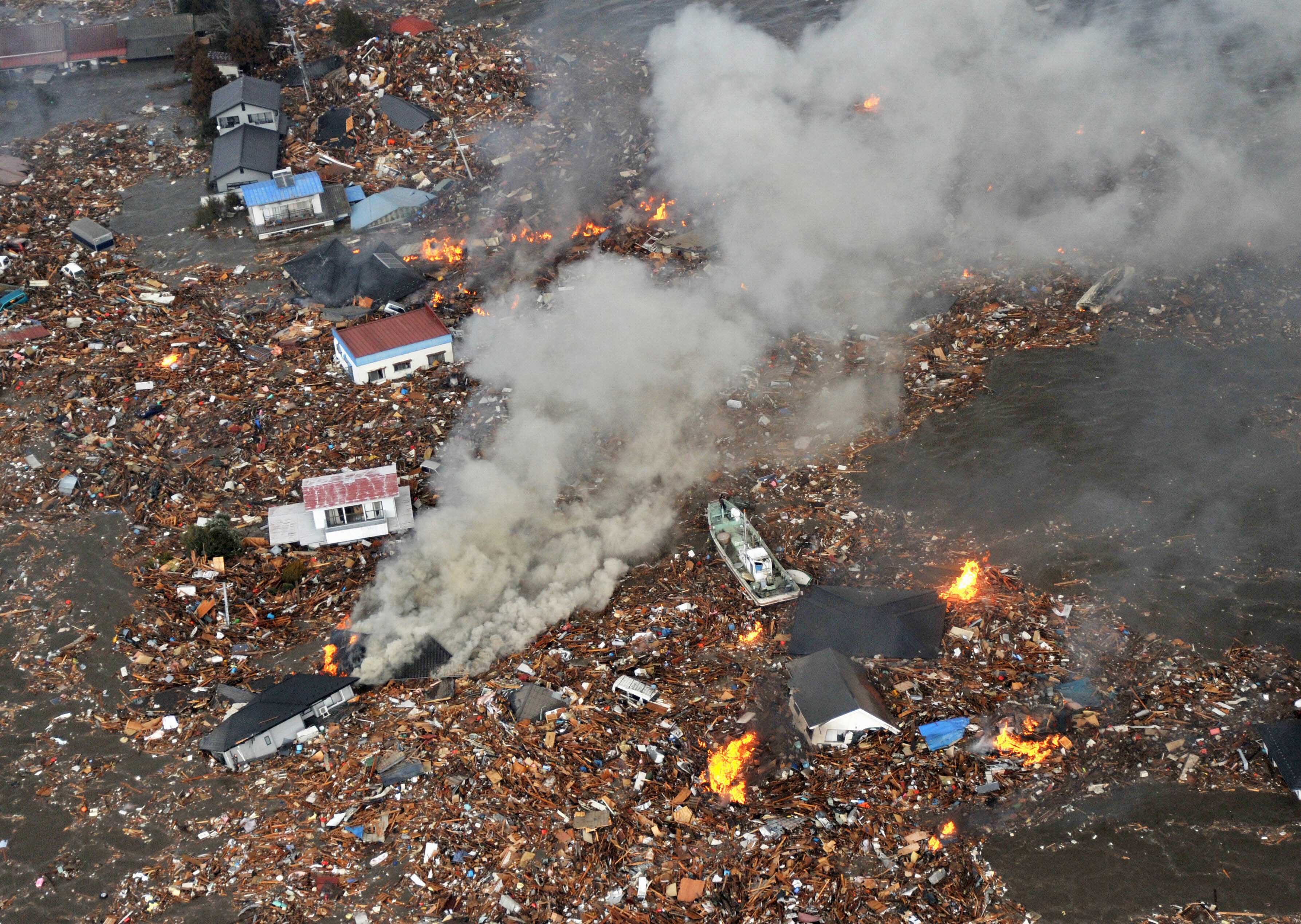UPDATE: Honolulu, other parts of Pacific brace for tsunami after Japanese earthquake
MALCOLM FOSTER, Associated Press
TOKYO - A powerful tsunami spawned by the largest earthquake in Japan's recorded history slammed the eastern coast Friday, sweeping away boats, cars, homes and people as widespread fires burned out of control. Tsunami warnings blanketed the entire Pacific, as far away as South America, Canada, Alaska and the entire U.S. West Coast.
Authorities said at least 32 people were killed. The magnitude 8.9 offshore quake was followed by at least 19 aftershocks, most of them of more than magnitude 6.0. Dozens of cities and villages along a 1,300-mile (2,100-kilometer) stretch of coastline were shaken by violent tremors that reached as far away as Tokyo, hundreds of miles (kilometers) from the epicenter.
A utility company in northeastern Japan reported a fire in a turbine building of nuclear power plant.
"The earthquake has caused major damage in broad areas in northern Japan," Prime Minister Naoto Kan said at a news conference.
Even for a country used to earthquakes, this one was of horrific proportions. It unleashed a 23-foot (7-meter) tsunami that swept boats, cars, buildings and tons of debris miles inland.
Large fishing boats and other sea vessels rode high waves into the cities, slamming against overpasses. Upturned and partially submerged vehicles were seen bobbing in the water.
Waves of muddy waters swept over farmland near the city of Sendai, carrying buildings, some on fire, inland as cars attempted to drive away. Sendai airport, north of Tokyo, was inundated with cars, trucks, buses and thick mud deposited over its runways. Fires spread through a section of the city, public broadcaster NHK reported.
The tsunami roared over embankments, washing anything in its path inland before reversing directions and carrying the cars, homes and other debris out to sea. Flames shot from some of the houses, probably because of burst gas pipes.
"Our initial assessment indicates that there has already been enormous damage," Chief government spokesman Yukio Edano said. "We will make maximum relief effort based on that assessment."
He said the Defense Ministry was sending troops to the quake-hit region. A utility aircraft and several helicopters were on the way.
A large fire erupted at the Cosmo oil refinery in Ichihara city in Chiba prefecture near Tokyo and was burning out of control with 100-foot (30 meter) -high flames whipping into the sky.
In northeastern Japan's Miyagi prefecture, a fire broke out in a turbine building of a nuclear power plant. Smoke was observed coming out of the building, which is separate from the plant's reactor, and the cause is under investigation, said Tohoku Electric Power Co. the company said.
There have been no reports of radioactive leaks or injuries, the company said. Several nuclear plants elsewhere along the coast were also partially shut down, with no reports of leakage.
Also from Miyagi prefecture, NHK showed footage of a large ship being swept away and ramming directly into a breakwater in Kesennuma city.
The U.S. Geological Survey said the 2:46 p.m. quake was a magnitude 8.9, the biggest earthquake to hit Japan since officials began keeping records in the late 1800s.
A tsunami warning was extended to a number of Pacific, Southeast Asian and Latin American nations, including Japan, Russia, Indonesia, New Zealand and Chile. In the Philippines, authorities said they expect a 3-foot (1-meter) high tsunami.
The quake struck at a depth of six miles (10 kilometers), about 80 miles (125 kilometers) off the eastern coast, the agency said. The area is 240 miles (380 kilometers) northeast of Tokyo.
In downtown Tokyo, large buildings shook violently and workers poured into the street for safety. TV footage showed a large building on fire and bellowing smoke in the Odaiba district of Tokyo. The tremor bent the upper tip of the iconic Tokyo Tower, a 333-meter (1,093-foot) steel structure inspired by the Eiffel Tower in Paris.
In central Tokyo, trains were stopped and passengers walked along the tracks to platforms. NHK said more than 4 million buildings were without power in Tokyo and its suburbs.
Large numbers of people waited at Tokyo's Shinjuku station, the world's busiest train station, for service to resume so they could go home. TV announcers urged workers not to leave their offices to prevent injuries in case of more strong aftershocks.
Osamu Akiya, 46, was working in Tokyo at his office in a trading company when the quake hit.
It sent bookshelves and computers crashing to the floor, and cracks appeared in the walls.
"I've been through many earthquakes, but I've never felt anything like this," he said. "I don't know if we'll be able to get home tonight."
Footage on NHK from their Sendai office showed employees stumbling around and books and papers crashing from desks. It also showed a glass shelter at a bus stop in Tokyo completely smashed by the quake and a weeping woman nearby being comforted by another woman.
Several quakes had hit the same region in recent days, including a 7.3 magnitude one on Wednesday.
Hiroshi Sato, a disaster management official in northern Iwate prefecture, said officials were having trouble getting an overall picture of the carnage.
"We don't even know the extent of damage. Roads were badly damaged and cut off as tsunami washed away debris, cars and many other things," he said.
Tokyo's main airport was closed. A large section of the ceiling at the 1-year-old airport at Ibaraki, about 50 miles (80 kilometers) northeast of Tokyo, fell to the floor with a powerful crash.
Dozens of fires were reported in northern prefectures of Fukushima, Sendai, Iwate and Ibaraki. Collapsed homes and landslides were also reported in Miyagi.
Japan's worst previous quake was in 1923 in Kanto, an 8.3-magnitude temblor that killed 143,000 people, according to USGS. A 7.2-magnitude quake in Kobe city in 1996 killed 6,400 people.
Japan lies on the "Ring of Fire" - an arc of earthquake and volcanic zones stretching around the Pacific where about 90 percent of the world's quakes occur, including the one that triggered the Dec. 26, 2004, Indian Ocean tsunami that killed an estimated 230,000 people in 12 nations. A magnitude-8.8 temblor that shook central Chile last February also generated a tsunami and killed 524 people.

